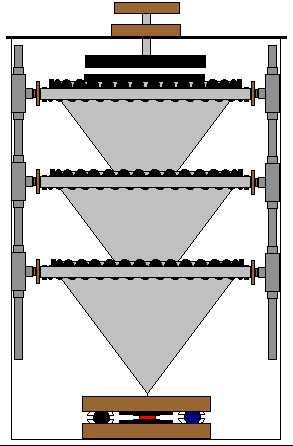Note that it is not recommended that you motorize your 45GD. There is a higher probability of success if you allow the magnets to do what they want to do.
This is my second attempt at building this device. Details of the correct way of building it are now more abundent although this version deviates from David's original in that he used ordinary bicycle rims for the cone rings whereas I am using aluminum strips of metal. The reason is that I could not find any bicycle rims which my magnets would fit into.
The current version of this uses Steve Thompson's idea of using a motor to make the cones wobble instead of the top repelling magnets.
The first step in construction involved assembling the parts on a wooden frame outside of the drum. The second step, now complete, involved putting it all in the drum and balancing it.
I have built a shorter oscillator for the Mark 2 so that I can have more clearance at the top of the drum for the motor (now) and for the 6" diameter repelling magnets (later).
The method for figuring out what gap to use between the cone rim and the opposing rings is to adjust the diameter of the opposing ring until the cone remains standing on its own but is almost floating. I am using the reverse of this approach. Since David Hamel had a gap of about 1/4" when not wobbling with a wobble of about 1/16", I decided to aim for this. I can't get a 1/4" gap because my rings and cone rims are very good circles but not perfect circles. Instead I want (and currently have) an average gap of 7/16" with a minimum of 6/16" and maximum of 8/16". But my initial cones are too light to almost float given a gap like this. Instead they leap up out of the opposing ring. So I increase their weight. I do this by putting small plastic bags of dirt in the bottom of the cones. The bags vary from 25 grams to 150 grams. So now the cones balance on their own within the 7/16" gap.
The Design
The following is the sought after end result. The measurements are given below the diagram.
|
- Cone height: 11.31 inches
- Cone outer diameter (including magnets): 16 inches
- The point of each cone sits 7.5 inches above the point of the cone that is it sitting on (i.e. 66% of the way up)
- It is estimated that the gap between cone ring magnets and outer ring magnets is around 7/16 inches.
- Top rejection magnets will have an outer diameter of 6 inches and an inner diameter of 4 inches. The is what David told me he'd used during a phone conversation
- Rejection magnets in oscillator, 4.5 inches outer diameter.
Further details can be found here:
- The Cones
- The Contruction Stand used early on in construction
- Method used to easily adjust height of repelling rings
- Views of inside the drum (showing oscillator and various cones)
The Motor Approach
While waiting for my 6 inch diameter magnets for the top repelling magnets, I decided to try Steve Thompson's motor approach. The idea here is to use a motor at the top of the drum to make the cones wobble instead of the repelling magnets. I'd tried this with my H45GD Mark 1 but failed because my gap size (distance between cone rim magnets and repelling ring magnets) was too large to be workable. With the Mark 2, the gap is only about 7/16" and therefore is workable.
Click here to see the construction details.
Results
July 9, 2000
I ran the device with the motor for about 1 hour. I had the holes in the drum cover closed most of the time, except to make observations.
- The rotation of the point of wobble was not measured exactly but was over 2 rotations per second.
- The magnitude of the wobble of the top cone was about 3/16". The magnitude of the wobble of the middle and bottom cones were much less, perhaps only 1/16".
- A smell, I think it was ozone, was coming from the drum.
- I inserted
the probe of an ion meter into one of the holes in the drum cover.
When the probe of the meter was in contact with the inner
cone skin of the top cone, the ion meter registered ionization.
The ionization measured fluctuated in sync with the wobble of
the cone. I could not tell if the ionization was greater
when the part of the cone I was touching was nearest the magnets.
Note that the ion meter was only capable of making relative
measurements, not absolute.
Click here for details of how the measurements were made.
With the above results in mind I extrapolated and came up with this theory for how it taps into zero point energy.


